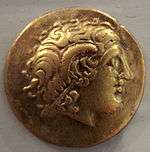Catuslugi
The Catuslougi (Gaulish: "troops of combat"; also Catuslugi, or Catoslugi) were a small Belgic coastal tribe, dwelling around modern-day Incheville (Normandy) during the Roman period.[1]
Name
Attestations
The Catuslugi are not mentioned by Caesar, and the name 'Catusl(o)ugi' is rendered from an allusion of Pliny the Elder ('the Catoslugi'), and two Gallo-Roman inscriptions referring to the region as 'Catuslou(gus)' and 'Catus(lougo)' (early-3rd c. AD).[2]
Etymology
The name Catuslogi ('troops of combat') is most likely an Hellenized form of Gaulish *Catu-slōg-, stemming from catu- ('combat') attached to slougo- ('troop, army, group').[3] The latter term derives from Proto-Celtic *slowgos ('troop, army'; compare with Old Irish slóg 'troop, army, crowd, assembly', or Welsh llu 'troop').[4][5] Its original meaning may have been 'those serving the chief' by the comparison with Balto-Slavic words that probably emerged from early linguistic contacts with Celtic speakers: Lithuanian slaugà ('service, servitude'), or OCS sluga ('servant').[4]
The region of pagus Catuslou(gus), attested by two Gallo-Roman inscriptions found in Briga (modern Bois L'Abbé, Eu), is most likely named after the tribe.[6][2]
Geography
Territory
The Catuslugi dwelled in the modern region of Normandy, near the coast of the Channel, around present-day Incheville and Eu.[7][8] Their territory was located between that of the Ambiani and Caletes.[9]
Settlements
The name of a town, Briga (Gaulish 'mount, hill'; modern Bois L'Abbé), appears on an inscription from the early 3rd century AD.[10] Briga has been erected in the late 1st c. BC on a plateau overlooking the Channel coast, in an upright position between the valley of the Bresle river in the north (where modern Eu is located), and the valley of Saint-Pierre-en-Val in the south.[8]
The site appears to have been abandoned between at the end of the 3rd century AD, perhaps around 280-290.[11] The departure of the city appears to have been planned by its inhabitants, who left in a short lapse of time after what archaeologist Étienne Mantel has interpreted as a ritual of deconsecration followed by the closure of the public moments.[12]
The settlement of Augum (Eu), founded in the nearby valley, became to new chief town.[13]
Au contraire, l’abandon paraît avoir été planifié, avec des rituels organisés pour rendre au monde profane les espaces consacrés, et un départ de la population de manière simultanée ou sur le laps de temps très court d’une ou de deux décennies
Incheville was also a central oppidum of the Catuslugi.[7]
Religion
The earliest evidence of a sanctuary in Briga is an area dedicated to the votive dumping of weapons, jewels and coins, dated the second part of the first century BC (perhaps 40–30). The practice, certainly linked to a late native cult of the waters, has persisted during the Julio-Claudian era.[14] Two small fanum temples of Gallic tradition were erected in the late first century AD, suggesting a first step in the "monumentalization" of the sacred area.[14]
A dedication from the early 3rd century AD, carved by a member of the local elite, attests the Roman influence on Catuslugi beliefs at that time, and the presence of an imperial cult in Briga. The main temple of the city may have been reserved to the Roman god Jupiter, or directly to the cult of Rome and Augustus.[15] The god 'Mercury Brigensis' (Mercury from Briga), also mentioned in the dedication, is probably a native Gallic deity assimilated into the Roman pantheon.[14]
Num(ini sive -inibus) Aug(usti sive -ustorum) Pag(o) Catus(lougo) I Iovio Mercurio Bri/gensi P. Magnius / Belliger Basilicam / D(e) S(uo) D(edit) [To the divine power of the Emperor, To the Pagus Catuslougus, to Jupiter and to Mercurius from Briga, Publius Magnius Belliger (has had erected) a basilica at his expense.]
— Eu inscription.[15]
References
- Wightman 1985, pp. 27, 54.
- Mantel, Dubois & Devillers 2006, p. 40.
- Delamarre 2003, pp. 111, 276.
- Delamarre 2003, pp. 276.
- Matasović 2009, p. 346.
- Wightman 1985, p. 54.
- Wightman 1985, p. 28.
- Mantel, Dubois & Devillers 2006, p. 32.
- Wightman 1985, p. 27.
- Mantel, Dubois & Devillers 2006, pp. 31, 38–39.
- Mantel & Dubois 2017, par. 3.
- Mantel & Dubois 2017, pars. 6–17.
- Mantel, Dubois & Devillers 2006, p. 35.
- Mantel, Dubois & Devillers 2006, p. 45.
- Mantel, Dubois & Devillers 2006, p. 44.
Bibliography
- Delamarre, Xavier (2003). Dictionnaire de la langue gauloise: Une approche linguistique du vieux-celtique continental (in French). Errance. ISBN 9782877723695.CS1 maint: ref=harv (link)
- Mantel, Etienne; Dubois, Stéphane; Devillers, Sophie (2006). "Une agglomération antique sort de l'anonymat (Eu, "Bois L'Abbé", Seine-Maritime) : Briga ressuscité". Revue archéologique de Picardie. 3 (1): 31–50. doi:10.3406/pica.2006.2434.CS1 maint: ref=harv (link)
- Mantel, Étienne; Dubois, Stéphane (2017). "L'agglomération de Briga (Eu, Bois-l'Abbé, Seine-Maritime) : premières données sur l'occupation durant l'Antiquité tardive". Gallia. 74 (1): 181–193. doi:10.4000/gallia.2427. ISSN 0016-4119.
- Matasović, Ranko (2009). Etymological Dictionary of Proto-Celtic. Brill. ISBN 9789004173361.CS1 maint: ref=harv (link)
- Wightman, Edith M. (1985). Gallia Belgica. University of California Press. ISBN 978-0-520-05297-0.CS1 maint: ref=harv (link)
